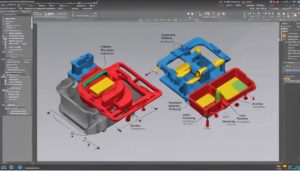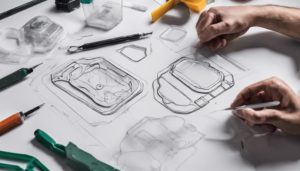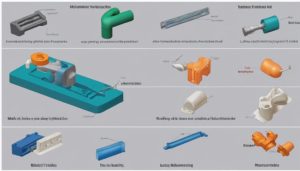Plastic injection molding begins with creating metal molds using CAD designs. The mold consists of a cavity and core for shaping thermoplastics. After melting plastic pellets in the injection screw, the molten material is injected into the mold cavity under high pressure, ensuring uniform distribution. Cooling and solidification follow to form the final product. Factors like mold material selection and design complexity play vital roles in the process. Understanding molding parameters like injection pressure and clamping force is essential. This efficient and cost-effective process is commonly used in industries like aerospace, medical, and automotive. Explore further for detailed insights on the intricacies of plastic injection molding.
Plastic Injection Molding Process Overview
Studying the plastic injection molding process offers a thorough understanding of the intricate steps involved in transforming raw plastic materials into precision-engineered components. Injection molding is a highly efficient manufacturing process that involves melting thermoplastic materials, injecting them into metal molds, and allowing them to cool and solidify to form various plastic parts.
The heart of this process lies in the metal molds, which are manufactured using CAD design and 3D printing technologies to create precise mold tools. These mold tools consist of a mold cavity and core, essential for shaping thermoplastics like ABS, Nylons, and Polypropylene.
The injection molding process is popular across industries due to its wide range of material options, allowing for versatility in component design and functionality. Its ability to produce complex geometries with high precision and consistency makes it a preferred choice for manufacturers looking to enhance manufacturing efficiency and overall product quality.
Selection of Thermoplastic Material

The selection of thermoplastic material in injection molding is a critical determinant of process success, influenced by factors such as mechanical properties, chemical resistance, and cost considerations. When choosing a thermoplastic material for injection molding, several key factors need to be considered:
- Mechanical Properties: Different thermoplastics offer varying levels of strength, flexibility, and impact resistance, which are pivotal for determining the suitability of the material for specific applications.
- Chemical Resistance: Understanding how a thermoplastic material reacts to different chemicals or environments is essential to guarantee the durability and longevity of the molded parts.
- Cost: The overall cost of the material, including raw material expenses, processing costs, and part performance, plays a significant role in material selection decisions.
- Common Thermoplastics: Materials such as ABS, Polypropylene, and Polycarbonate are popular choices in injection molding due to their versatile properties and widespread availability.
Careful consideration of these factors is essential to optimize part performance and ensure the successful production of high-quality plastic components.
Melting and Feeding Process

Considering the critical role of precise material temperatures in the injection molding process, the melting and feeding process in injection molding commences with the introduction of plastic pellets into the hopper of the machine. The plastic pellets are then conveyed into the injection screw, where they undergo the melting process. The injection screw gradually heats and melts the thermoplastic material, guaranteeing it reaches a consistent temperature suitable for injection. During this stage, maintaining precise temperatures is vital to guarantee the efficient injection of the molten plastic into the mold cavity.
Proper temperature control and pressure management are essential components of the melting and feeding process in injection molding. The molten plastic, once at the ideal temperature, is then injected into the mold cavity under pressure. This pressure application is necessary to ensure that the mold cavity is completely filled with the molten plastic, resulting in accurate and high-quality plastic parts. Mastering the melting and feeding process is fundamental for achieving successful results in the injection molding of plastics.
Injection of Molten Plastic

Initiating the injection of molten plastic is a vital phase in the injection molding process, necessitating precise control of pressure and speed to guarantee uniform filling of the mold cavity. The injection process plays an essential role in shaping the final product, ensuring that the molten plastic material is distributed evenly and completely within the mold. To achieve this, high pressure is applied to the molten plastic to facilitate its flow into all the intricate details of the mold cavity. Controlling the injection speed is equally important as it helps prevent defects such as air bubbles or incomplete filling, which could compromise the quality of the final plastic part. Properly injecting the molten plastic is fundamental for creating high-quality and accurate plastic components that meet the desired specifications.
- Molten plastic is injected into the mold cavity at high pressure to fill the desired shape.
- The injection process ensures that the plastic material flows uniformly and completely throughout the mold.
- Injection speed and pressure are carefully controlled to prevent defects like air bubbles or incomplete filling.
- The molten plastic solidifies within the mold, taking the shape of the cavity and forming the final product.
Cooling and Solidification Phase

The cooling and solidification phase in injection molding is a critical stage where the molten plastic changes into a solid state within the mold. Proper control of the cooling process is crucial to prevent defects and guarantee uniform hardening of the plastic material.
Understanding the interplay between cooling rate, temperature regulation, and solidification time is essential for achieving high-quality, dimensionally accurate plastic parts.
Cooling Process Overview
Proper management of the cooling process in injection molding is essential to ensuring the accurate solidification of the plastic material within the mold cavity. During this phase, several critical aspects need to be considered for effective cooling and solidification:
- Cooling time: The duration the plastic material needs to cool and solidify adequately.
- Proper cooling: Ensuring the right temperature and cooling rate to prevent defects.
- Prevent warping: Effective cooling helps in avoiding deformations or warping in the final product.
- Maintaining dimensions: Controlling cooling to retain the exact shape and size of the injected part.
Solidification Stage Importance
Within the injection molding process, the solidification stage holds paramount importance in determining the structural integrity and material properties of the final part. Proper cooling time is pivotal to prevent warping, shrinkage, or internal stresses in the plastic part.
The rate of cooling directly impacts the quality, surface finish, and dimensional accuracy of the part. Uniform solidification, achieved through precise cooling process control, is essential to avoid defects like sink marks or voids. By adhering to specific cooling requirements tailored to different materials, manufacturers can optimize part quality and production efficiency.
Mastering the solidification stage is fundamental in ensuring the overall success of the injection molding process.
Ejection of Final Part

Using ejector pins or plates is a vital step in the injection molding process for ejecting the final part efficiently. The ejection system is essential for removing parts from the mold cavity without causing damage to the final product. This process guarantees the continuous and smooth production of plastic components.
- Ejector pins or plates are strategically placed in the mold to push the final part out once it has solidified.
- The ejection system is designed to release the part smoothly and precisely to avoid any deformation or damage.
- Efficient ejection is critical for maintaining the production cycle times and ensuring the quality of the plastic parts.
- Proper ejection not only aids in the removal of the part but also contributes to the overall productivity and cost-effectiveness of the injection molding process.
Tooling Considerations

When considering tooling in injection molding, critical points to assess include the selection of appropriate tooling materials, the complexity of mold design, and the efficiency of the cooling system.
The choice of tooling material impacts factors such as durability and maintenance requirements, while mold design complexity directly affects part quality and production efficiency.
Additionally, an efficient cooling system is essential for achieving best cycle times and ensuring consistent part dimensions.
Tooling Material Selection
Selecting the appropriate material for tooling is a critical decision in ensuring the durability and efficiency of the injection molding process. Steel and aluminum are popular choices for tooling materials due to their ability to endure heating and cooling cycles. Tooling materials must possess high hardness and wear resistance to uphold precision during molding operations. The quality, accuracy, and consistency of the final plastic parts are directly influenced by the selection of the tooling material. Opting for the right tooling material can lead to reduced maintenance costs and an overall increase in the efficiency of the injection molding process.
- Steel and aluminum are common materials for tooling
- High hardness and wear resistance are essential
- Tooling material choice impacts part quality and consistency
- Proper material selection can decrease maintenance costs and boost efficiency
Mold Design Complexity
What key considerations influence the complexity of mold design in plastic injection molding processes?
The complexity of mold design is heavily influenced by factors such as part geometry, undercuts, cores, and ejector systems. Designing molds that accommodate intricate part geometries, undercuts, and the integration of cores and ejector systems adds layers of complexity to the tooling. Additionally, considerations like draft angles, wall thickness uniformity, and the inclusion of cooling channels impact mold design complexity.
Achieving tight part tolerances necessitates the incorporation of precise features and complex geometries within the mold design. These intricate designs, often created using advanced CAD/CAM technologies, are essential for ensuring the production of high-quality plastic parts with the desired specifications.
Cooling System Efficiency
Considering the critical role of cooling systems in injection molding processes, the efficiency of the cooling system directly impacts production cycle times and overall part quality.
- Efficient cooling systems help achieve uniform cooling to prevent warping and shrinkage.
- Proper cooling design maintains consistent temperatures for best part quality.
- Controlling cooling rates is essential for influencing part dimensions, surface finish, and material properties.
- Effective cooling systems not only contribute to cost savings but also lead to improved overall part quality in injection molding processes.
Designing for Injection Molding

Designing for injection molding demands meticulous attention to part geometry, wall thickness, and draft angles to guarantee efficient manufacturability and product quality. Maintaining uniform wall thickness is vital as it helps prevent defects such as warping and sink marks in the final molded part. Incorporating fillets and radii at sharp corners aids in promoting smooth material flow during injection, reducing the likelihood of stress concentrations.
Additionally, proper gating design is essential to make sure the even distribution of molten material within the mold cavity, while venting design allows for the effective escape of air during the filling process, leading to high-quality parts. Design considerations also extend to optimizing parting lines, ejector pin placement, and slide actions to facilitate seamless production and ejection of molded components.
Advantages of Injection Molding

Injection molding presents numerous advantages in the manufacturing of plastic components, offering unparalleled precision and design flexibility for intricate parts.
- High Precision: Injection molding allows for the creation of intricate parts with small tolerances, ensuring high precision in the final product.
- Material Versatility: A wide range of material choices are available for injection molding, including options like antistatic plastic and thermoplastic rubber, providing flexibility in material selection.
- Design Flexibility: Injection molding enables the incorporation of various features in small parts, offering design flexibility to meet specific requirements.
- Efficient Production: The process of injection molding provides efficient and cost-effective production of plastic parts with consistent quality, making it a preferred method for manufacturing plastic components.
These advantages make injection molding a popular choice in the manufacturing industry for producing high-quality plastic parts with intricate designs and precise specifications.
Understanding Molding Parameters

Building on the foundation of advantages injection molding offers, a thorough understanding of molding parameters is essential for achieving ideal results in plastic component production.
Injection pressure, typically ranging from 500 to 1500 bar, is vital for proper material flow during the molding process.
Controlling mold temperature is critical as it directly impacts the quality of finished parts.
Nozzle pressure plays a significant role in ensuring consistent material injection throughout the molding cycle.
The recovery rate is essential for enhancing production efficiency and reducing cycle times in plastic injection molding operations.
Additionally, clamping force is necessary to securely hold the mold halves together during both the injection and cooling stages of the process.
Applications of Injection Molding

With a proven track record across aerospace, medical equipment, and automotive sectors, injection molding stands out as a pivotal manufacturing process for creating intricate and complex parts.
- Injection molding is commonly used for producing plastic parts in aerospace, medical equipment, and automotive industries.
- Specialized techniques like overmolding and insert molding within injection molding cater to the creation of complex and intricate components.
- The efficiency and cost-effectiveness of injection molding make it ideal for mass production of parts.
- This versatile process extends its applications to industries such as building and construction, medical fields, and consumer goods, ensuring consistent quality and precision in the manufactured products.
Injection molding plays an important role in the manufacturing sector by enabling the production of a wide range of commodities and household items efficiently and with high precision.
Frequently Asked Questions
What Are the 5 Steps of Injection Molding?
The five steps of injection molding are:
- Thermoplastic selection
- Feeding and melting
- Injection into the mold cavity
- Holding and cooling
- Ejection and finishing
These steps involve selecting the appropriate material, melting it using an injection screw, controlling the injection process through the gate, ensuring proper packing and solidification, and finally, removing the finished product from the mold and preparing it for distribution.
Is Plastic Injection Molding Difficult?
Is plastic injection molding difficult?
Achieving mastery in plastic injection molding demands a profound understanding of material behavior, tooling intricacies, and process nuances. The complexity lies in meticulously controlling variables like temperature, pressure, and cooling rates to guarantee impeccable outcomes.
Skilled operators play a pivotal role in monitoring and adjusting the injection molding process to secure consistent quality and optimize production efficiency. Proficiency in addressing challenges such as plastic flow dynamics and part ejection is paramount for success in this intricate field.
Why Does Plastic Shrink After Injection Molding?
Plastic shrinks after injection molding primarily due to the cooling and solidification processes involved. As the molten plastic cools and transforms into a solid form, it undergoes contraction, leading to dimensional changes.
Several factors, such as material properties, part geometry, and processing conditions, influence the extent of shrinkage. Proper mold design and precise control of processing parameters are essential in managing and minimizing shrinkage to guarantee the production of accurate and dimensionally stable plastic parts.
What Is the Basic Knowledge of Injection Molding?
Injection molding is a complex manufacturing process that involves melting plastic resin and injecting it into a mold to form a desired shape. Understanding the fundamentals of mold design, material selection, and surface finishes is essential for successful outcomes.
Factors like temperature control, cooling rate, and pressure play pivotal roles in ensuring quality and precision. Adhering to these principles is vital for achieving consistent and reliable results in injection molding processes.
Conclusion
To sum up, injection molding of plastics is a complex process that involves selecting thermoplastic materials, melting and feeding them into a mold, injecting the molten plastic, and then cooling and solidifying the product.
This method offers many advantages, such as high production rates and cost-effectiveness.
For example, a case study of a company producing automotive parts using injection molding shows how precise design and molding parameters can result in high-quality products with minimal waste.







